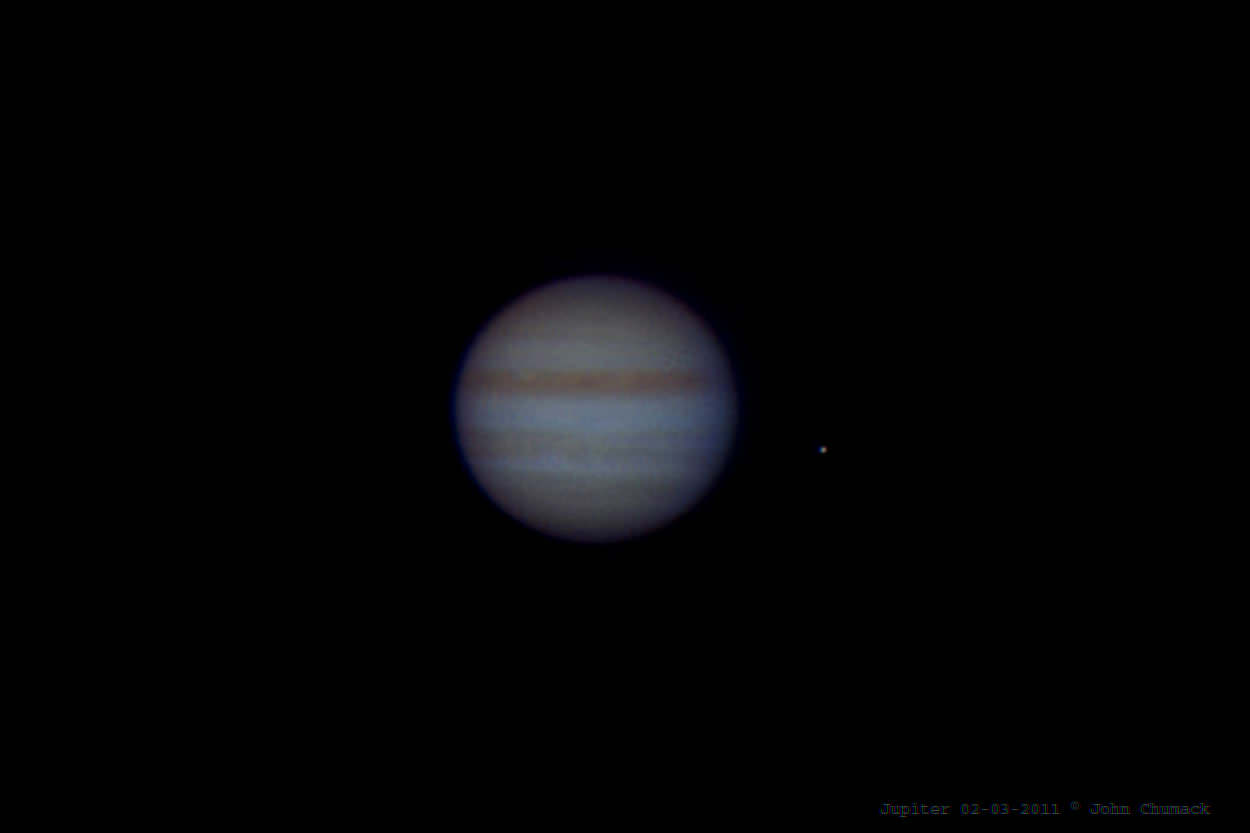As we know, Jupiter’s Southern Equatorial Belt has been missing beneath its icy clouds for almost a year now. While astronomers are able to use instruments like Keck – complete with infrared and adaptive optics – we here on Earth have to take our views of Jupiter a little more naturally.
As you can see from this webcam image given to us by John Chumack, even our thin earthly clouds can’t quite hide bright Jupiter. It has returned to the same ruddy, lined face that most of us fell in love with the first time we observed it. Stunning details? No… Because this is how Jupiter really looks when you first glimpse it in the eyepiece.
Right now the westering Jupiter isn’t in the best of positions for extended observing, but it is at a comfortable height and a comfortable time. While it might be tempting to throw a huge amount of magnification its way, it actually makes the view worse rather than improving it. With steady seeing condtions, around 150-200X is ideal – reducing the magnification even lower if the atmosphere is turbulent. You’ll find you’ll also have greater success using your orthoscopic or plossl design eyepieces, too. Got color filters? Go ahead and experiment! Blues, reds and yellows all cause contrast change which can reveal subtle details. As unusual as it may sound, sketching also helps. You don’t need to be a Rembrandt. Just the act of translating what the eye sees onto paper greatly improves your “human” focus.
Don’t forget the galiean moons! As you can see, Europa can look like a world of its own. While larger aperture instruments are able to resolve events like shadow transits, don’t feel left out if you have a small telescope. It’s very exciting to witness one of Jupiter’s satellites being eclipsed by the parent planet – or disappearing as it passes in front. There are even times when the moons eclipse each other! Go on… Take advantage of the early evening hours and enjoy Jupiter.
Because you never know when the perfect moment seeing will arrive…
Many thanks to John Chumack of Galactic Images for sharing his recent image of Jupiter with us.


Mmm… perfect seeing… I like! Am sure most amateurs have had nights like that? Perhaps a night so clear that you don’t notice the ice and cold or heat and mosquitoes? Yes, a night when your telescope performs flawlessly and is able to easily and clearly see things you’ve never seen before! Maybe S/N remnants and Nebula without filters! or Andromeda’s globular clusters! Maybe even the deepest/faintest object yet – a giga-LY distant quazar/blazar? Yass! There are night’s like that.
…or Jupiter’s Red spot and the swirls surrounding it, as Europa passes by….
pssst…. aqua?
one time i was really patient (and fascinated) watching saturn with a 31″. the “seeing” was iffy – you know, the little whoops and rolls the atmosphere makes – and i just kept on watching just because i was entranced by the little moons i never see in a smaller scope. all at once a pocket of stability popped up out of nowhere and i personally had the opportunity to witness spoking in saturn’s rings. i felt blessed by the sky gods because that’s something very few people ever see. (and you’re darn right i had someone with me to confirm it!)
jupiter is also the same way. i was just sitting there, kinda’ depressed because it was a moonlit night and i was playin’ with my workhorse 4.5″ reflector. my mind was busy trying to figure out if the GRS was emerging around the edge (or i was imagining it) when all at once… poof! an atmospheric hole of stability and a perfect little black hole on jupiter’s surface where a moon was casting a shadow!
deep sky can be the same way. never give up hope… because dreams really do come true when you keep on reaching for the stars!